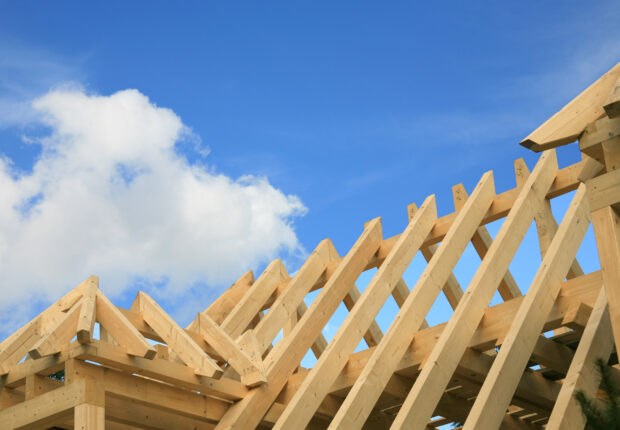The soaring price of lumber was one of the hottest topics on the lips of industry executives speaking at midyear conferences, becoming a focus of discussion almost as often as cyber risks and social inflation.
Executive Summary
While a trio of industry CEOs unanimously agreed that social inflation will have a profound near-term impact on their businesses at a recent industry event, discussions about lumber prices and potential power outages caught our attention.During the 37th Annual Insurance Conference hosted by S&P Global Ratings last week, John Neal, chief executive officer of Lloyd’s of London, led off a discussion on social inflation and then pointed to general economic inflation as one of the second-order impacts of COVID.
“The price of timber is up 40 percent. The price of fittings is up 20 percent. There is a supply chain impact” of COVID and work-from-home behaviors. “Provided we’re alert when we price [insurance], we’re OK,” he said.
Financial analysts generally attribute rising lumber prices to decreasing supply and rising demand, with supply having dropped because of lumber mill shutdowns in the early months of the pandemic, and demand lifting skyward with the rising pace of remodeling and rebuilding projects.
Dino Robusto, chair and CEO of CNA, said insurance pricing is keeping up with inflationary trends. “Everyone is focused on it. Everyone is watching it. Everyone would be inclined to capture it within their long-run loss cost trends, exposure change trends, and then let the required price needs emerge,” he said, adding that property/casualty insurers have the good fortune of being in a market in which they can raise prices.
So, why all the chatter? What’s the problem?
In two words: “demand surge.”
Peter Zaffino, president and CEO of AIG, filled in the specifics in response to a question from S&P Senior Director and Panel Moderator Larry Wilkinson about the insurance industry implications of a June 10 U.S. Labor Department report—released on the day of the S&P conference session—revealing that the Consumer Price Index jumped 5 percent for the year, the largest 12-month increase since August 2008.
Noting that lumber prices in the U.S. are catapulting above the figure that Neal referenced from where he’s sitting in the UK, Zaffino agreed with Robusto that the CPI news wasn’t a surprise to insurers who hone in on economic trends. But there could be more bad news ahead for the industry, he suggested, inviting conference attendees to think about the dynamics of property insurance, in particular.
“What happens a lot of times during cat season is you always worry about the big second event because of demand surge and things that happen after the first event. We’re already seeing that one of the effects of the pandemic was people moving into peak zones,…prices being driven up, supply starting to contract and the density being concerning.”
Conan Ward, RibiQon Risk and Insurance Services/RubiQon Re
“When you look at that and already [are] starting to see the type of demand surge pricing before the event, it’s something that we’re just going to watch as an industry…If there is something that happens during wind season, or another catastrophe that happens in an area that’s dense, it’s going to be challenging,” he said.
Two days earlier, at the Casualty Actuarial Society Seminar on Reinsurance, Conan Ward, president and general manager of RibiQon Risk and Insurance Services/RubiQon Re, a managing general agency subsidiary of QOMPLX, used different words to describe the same problem.
“We’ve talked about social inflation for years, and we’ve been lucky enough to not have to talk about real inflation. [But now], look at the CPI and the jump that’s gone on there. If the industry is in for a bad storm season, ‘Katy, bar the door’ because the supply chain is going to take a while to catch up…Lumber, drywall, pipe, roofing materials, windows—you just can’t get this stuff for love or money right now. And those prices are going way up. If you have a Category 3, 4 or 5 in Florida this year, I don’t know how people are going to find material to rebuild.”
Dino Robusto, CNA
Greg Henrick, CEO of Vantage Group Holdings, said that so far, supply issues have not had an impact on claims costs, referring to his company’s experience with Winter Storm Uri. “The feedback we’ve been getting from a handful of clients is that they’re maybe a little bit delayed, but they’re able to get work done. However, that’s not the same as having a Category 4 plowing through Florida,” he agreed. “It certainly seems like the system is wound up for bad news if there is a big event on a supply chain.”
Ward noted that the supply chain issue is getting exacerbated by the rebuilding in the Northern states as the weather in those states improves and they come out of COVID. So, the demand on supplies in the North has gone way up, and it’s not like the Southern states were able to find what they needed before that. I’m glad that folks out in Texas are getting what they need to rebuild. I would say knowing Florida pretty well, people building new down there are not getting what they need…Prices are up 3X, in some cases even more,” Ward reported.
“That may be the answer. They’re not rebuilding in Texas; they’re repairing,” Hendrick said, explaining his company’s dissimilar experience.
(Editor’s Note: The executives spoke at conferences held during the second week of June. On June 21, reports of lumber price drops started to emerge.)
Social Inflation or Climate Change?
Back at the S&P conference, Wilkinson asked Robusto, Neal and Zaffino—and nearly 1,000 analysts and executives attending the event—to choose an item that they believed would have the most impact on the insurance industry in the next three to five years. More than half of the audience (54 percent of respondents) voted for climate volatility.
Dan Hogan, Liberty Mutual
The cost of lumber wasn’t even one of the choices, which also included social inflation (23 percent), InsurTech (16 percent) and regulation (7 percent).
As the audience votes were being tallied, the executives put in their votes, unanimously picking social inflation. “It might’ve been obfuscated with the effects of the pandemic and the court dockets, etc. But it [has], by no way, been diminished and is a serious public enemy to the industry,” Robusto said, leading off for the trio.
Neal, who focused on the short time frame referred to in the question to reject climate in favor of social inflation as well, expressed the view that “we need to look at climate positively” at another point in the session. “It could be the largest single underwriting and investment opportunity we get to see in our careers,” he said.
“It’s giving us a real option to design new products and services that are relevant to where governments and policy want to take their vision of the green industrial revolution. It does take us into a broader understanding of systemic risks and creates a huge investment opportunity for us,” he said.
The opportunities would be easy to grab onto, however. “Have we got all the skills that we need? No, we haven’t. Are governments designing all the policies that give us the help? No, they’re not. Are the regulators giving us all the help that they need? No, they’re not. So, there’s a lot more to do on it, [but] I think, as an industry, we need to be brave and accept that this is one of those times where we’ve got to pat our heads and rub our tummies at the same time. We need to be able to represent where policy, society, government wants us to go. But equally, we need to be brave and say someone needs to constructively insure transition. You can’t walk away from transition…”
“If there’s nobody prepared to insure the transition that takes us from a carbon-dependent world to a non-carbon-dependent world, then we’ll never get there…As an industry, we’ve got to be smart and brave and do both,” Neal concluded.
Lights Off
At a separate session of the S&P conference featuring a trio of chief risk officers of insurers and reinsurers, cyber risks, climate change, economic and social inflation were the topics most discussed when the CROs were asked to name the biggest risks flashing on their emerging risk dashboards.
After executives at multiple conference sessions during the S&P and CAS meetings highlighted systemic risks of a global pandemic and potential cyber catastrophes, Dan Hogan, senior vice president of enterprise risk management for Liberty Mutual, had one more to add to that category. “One of our top emerging risks is a severe power outage,” he said. Power outages themselves can be caused by both human-made and natural events, as we all saw in Texas this year…Regardless of costs, the result is the same: immense human suffering, significant disruptions in economic activity and, depending on the time of year, widespread property damage,” Hogan said.
“We take for granted the ability to work remotely and have conferences like this,” he continued. “Think about what it would be like without power, without the Internet. It would be quite a challenge,” he concluded.
(For more coverage of the S&P and CAS conferences, see related online article: “CEO Viewpoints: Recounting Success and Failure in Dealing With Pandemic Challenge“)






















 How One MGU Grew Fivefold When Capacity Fled Cat-Prone Property Markets
How One MGU Grew Fivefold When Capacity Fled Cat-Prone Property Markets  What to Expect in 2026: U.S. P/C Results More Like 2024
What to Expect in 2026: U.S. P/C Results More Like 2024  Police Recover Swallowed Fabergé Pendant 6 Days After it Was Stolen
Police Recover Swallowed Fabergé Pendant 6 Days After it Was Stolen  Water Leaks, Frozen Pipes Top List of Small Business Claims: The Hartford
Water Leaks, Frozen Pipes Top List of Small Business Claims: The Hartford 






